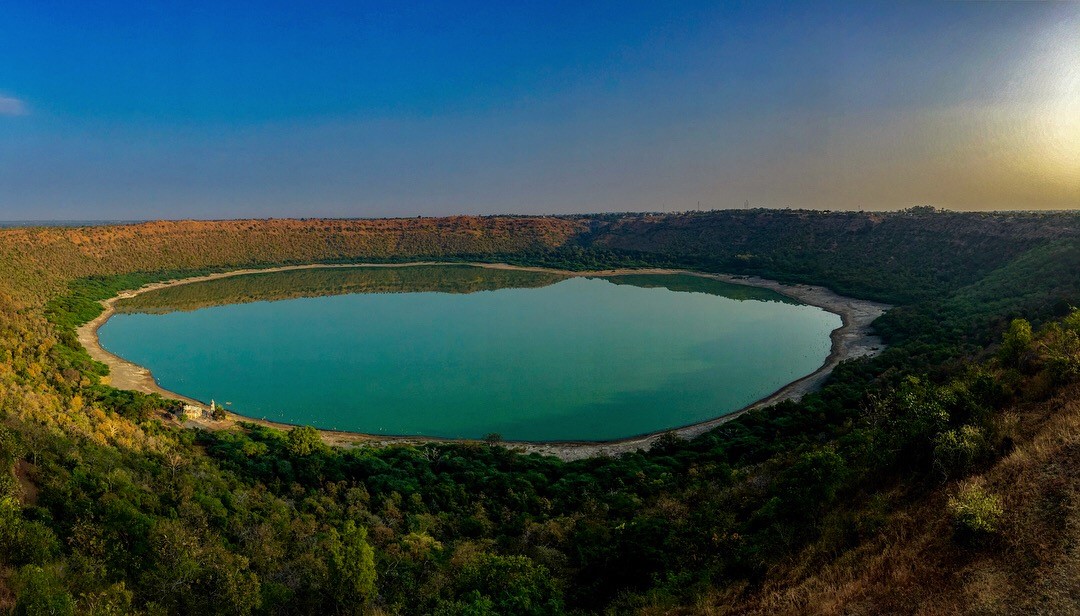古代核戦争
インド中部にあるクレーター湖"Lonar Lake"は、Jourdan et al(2011)によれば、アルゴンによる推定で57万年前に隕石の衝突で形成された。
(wikipedia: Lonar Lake)
Jourdan et al ((2010), 2011)が推定するまでは、5万年前に形成されたと考えられていた。
Lonar Lakeの形成年代が5万年前だと考えられていた頃(2010年以前)には、Lonar Lakeが核爆発の跡地だと言う、古代核戦争論者がいた。

Childressは推定年代が変わったことに気付いておらず、Childressの記述を信じて同様の主張を2011年以降にもした者もいる。

年代が合わなくったことに気づいていない例はほかにもある。

論拠に使った先行研究に修正が加えられるというのは、ありがちなことで、普通の研究でも同様のことは起きたりするので、これは致し方ないかもしれない。
インド中部にあるクレーター湖"Lonar Lake"は、Jourdan et al(2011)によれば、アルゴンによる推定で57万年前に隕石の衝突で形成された。
| 所在地 | インド, マハラシュトラ州ブルダナ地方 |
| 座標 | 東経19°58′30″北緯76°30′27″ |
| 種別 | 隕石衝突によるクレーター湖, 塩湖 |
| 最大幅 | 1830m |
| 表面積 | 1.13km2 |
| 平均深度 | 137m |
| 推定年代 | 570,000 ± 47,000年 |
 |  |
| wikimedia.commons | wikimedia.commons |
Jourdan et al ((2010), 2011)が推定するまでは、5万年前に形成されたと考えられていた。
Lonar Lakeの形成年代が5万年前だと考えられていた頃(2010年以前)には、Lonar Lakeが核爆発の跡地だと言う、古代核戦争論者がいた。
Another curious sign of an ancient nuclear war in India is a giant crater near Bombay. India's nearly circular 2,154-meter diameter Lonar crater, located 400 kilometers northeast of Bombay and aged at less than 50,000 years old, could be related to nuclear warfare of antiquity. No trace of any meteoric, etc., material has been found at the site or in the vicinity, while it is the world's only known 'impact' crater in basalt. Indications of great shock (from a pressure exceeding six hundred thousand atmospheres) and intense abrupt heat (indicated by basalt glass spherules) can be ascertained at the site.
インドでの古代の核戦争のもう一つの奇妙な兆候は、ボンベイ近くの巨大なクレーターである。ボンベイの北東400キロに位置し、5万年未満の年代のインドのほぼ円形の直径2,154メートルのロナールクレーターは、古代の核戦争に関連している可能性がある。玄武岩中の世界で唯一知られている「衝突」クレーターであるが、その場所またはその周辺では、隕石などの物質の痕跡は発見されていない。大きな衝撃(60万気圧を超える圧力による)と激しい急激な熱(玄武岩ガラス球によって示される)の兆候は、現場で確認できる。
[ David Hatcher Childress: "Technology of the Gods -- The Incredible Sciences of the Ancients" (2000) ]
インドでの古代の核戦争のもう一つの奇妙な兆候は、ボンベイ近くの巨大なクレーターである。ボンベイの北東400キロに位置し、5万年未満の年代のインドのほぼ円形の直径2,154メートルのロナールクレーターは、古代の核戦争に関連している可能性がある。玄武岩中の世界で唯一知られている「衝突」クレーターであるが、その場所またはその周辺では、隕石などの物質の痕跡は発見されていない。大きな衝撃(60万気圧を超える圧力による)と激しい急激な熱(玄武岩ガラス球によって示される)の兆候は、現場で確認できる。
[ David Hatcher Childress: "Technology of the Gods -- The Incredible Sciences of the Ancients" (2000) ]
Childressは推定年代が変わったことに気付いておらず、Childressの記述を信じて同様の主張を2011年以降にもした者もいる。
The Lonar crater in India is less than 50,000 years old. Researcher David Hatcher-Childress (1957—), in his 2014 report, "Giant Unexplained Crater Near Bombay," speculates it could be evidence of an ancient nuclear war.
インドのロナールクレーターは5万年未満の年代に形成された。研究者David Hatcher-Childress(1957〜)、2014年の報告書「ボンベイ近くの巨大な原因不明のクレーター」で、それが古代の核戦争の証拠である可能性があると推測している。
[ Nick Redfern: "Secret History -- Conspiracies from Ancient Aliens to the New World Order" (2015) ]
インドのロナールクレーターは5万年未満の年代に形成された。研究者David Hatcher-Childress(1957〜)、2014年の報告書「ボンベイ近くの巨大な原因不明のクレーター」で、それが古代の核戦争の証拠である可能性があると推測している。
[ Nick Redfern: "Secret History -- Conspiracies from Ancient Aliens to the New World Order" (2015) ]
年代が合わなくったことに気づいていない例はほかにもある。
Archaeologist Francis Taylor stated that etchings he translated in some nearby temples suggested that the local population prayed to be spared from the great light that was coming to lay ruin to the city. "It's so mind-boggling to imagine that some civilization had nuclear technology before we did. The radioactive ash adds cred-ibility to the ancient Indian records that describe atomic warfare."I3 Another curious sign of ancient nuclear war in India is a giant crater near Mumbai (formerly Bombay). The nearly circular Lonar crater has a diameter of 7,064 feet, is located 250 miles northeast of Mumbai, and is dated at around 50,000 years old. No trace of any meteoric material or the like has been found at the site or in its vicinity, and this is the world's only known "impact" crater in basalt. Indications of great shock (from pressure exceeding 600,000 atmospheres) and intense, abrupt heat (indicated by basalt glass spherules) can be ascertained from the site.
考古学者のフランシス・テイラーは「自分が翻訳した近くの寺院のエッチングは、地元の人々が街を荒廃させようとしている大きな光から逃れられるように祈っていたことを示唆している」と述べた。 「ある文明が我々よりも前に核技術を持っていたと想像するのはとても気が遠くなるようなものだ。放射性ダストは、核戦争を説明する古代インドの記録に信頼性を高める。ムンバイ(旧ボンベイ)の近く、ほぼ円形のLonarクレーターは直径2020メートルで、ムンバイの北東402km位置し、約50,000年前のものである。この場所やその周辺には隕石などの痕跡は見つかっておらず、世界で唯一知られている玄武岩の「衝突クレーター」である。大きな衝撃 (600,000気圧を超える圧力による) と強烈な急激な熱 (玄武岩のガラスの小球体によって示される) の兆候を現場から確認できる。
[ Philip Coppens: "The Ancient Alien Question, 10th Anniversary Edition" (2021), p.176 ]
考古学者のフランシス・テイラーは「自分が翻訳した近くの寺院のエッチングは、地元の人々が街を荒廃させようとしている大きな光から逃れられるように祈っていたことを示唆している」と述べた。 「ある文明が我々よりも前に核技術を持っていたと想像するのはとても気が遠くなるようなものだ。放射性ダストは、核戦争を説明する古代インドの記録に信頼性を高める。ムンバイ(旧ボンベイ)の近く、ほぼ円形のLonarクレーターは直径2020メートルで、ムンバイの北東402km位置し、約50,000年前のものである。この場所やその周辺には隕石などの痕跡は見つかっておらず、世界で唯一知られている玄武岩の「衝突クレーター」である。大きな衝撃 (600,000気圧を超える圧力による) と強烈な急激な熱 (玄武岩のガラスの小球体によって示される) の兆候を現場から確認できる。
[ Philip Coppens: "The Ancient Alien Question, 10th Anniversary Edition" (2021), p.176 ]
論拠に使った先行研究に修正が加えられるというのは、ありがちなことで、普通の研究でも同様のことは起きたりするので、これは致し方ないかもしれない。


コメントをかく